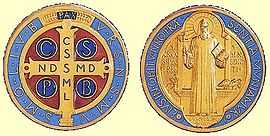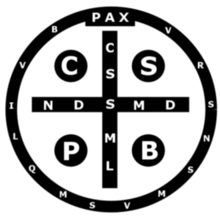Saint Benedict Medal

The Saint Benedict Medal is a Christian sacramental medal containing symbols and text related to the life of Saint Benedict of Nursia, used by Roman Catholics, as well as Anglicans, Lutherans, Methodists and the Western Orthodox, in the Benedictine Christian tradition, especially votarists and oblates.[1][2]
The medal is one of the oldest and most honored medals used by Christians and due to the belief in its power against evil is also known as the "devil-chasing medal".[3] As early as the 11th century, it may have initially had the form of Saint Benedict's cross, and was used by pope Leo IX.[3]
The reverse side of the medal carries the Vade retro satana ("Step back, Satan") formula which has been used by Christians to ward off evil since the 15th century.[4] Sometimes carried as part of the rosary, it is also found individually.
In widespread use after its formal approval by pope Benedict XIV in the 18th century, the medal is used by Roman Catholics to ward off spiritual and physical dangers, especially those related to evil, poison, and temptation.[3][2]
History

The exact time and date of the making of the first Saint Benedict Medal are not clear, however, it is likely that may have initially had the form of a cross.[3] Catholic tradition holds that as a young Benedictine, the future Pope Leo IX attributed his recovery from a snake bite to that cross.[3] After becoming pope in 1049, Leo IX enriched the St. Benedict cross to the form of a medal, and gave it blessings and indulgences.[3]
Saint Vincent de Paul, who died in 1660, appears to have been acquainted with the Medal and the Sisters of Charity founded by him have worn it attached to their rosary beads.[5]
The medal was formally approved by Pope Benedict XIV in 1741.[3] The Jubilee medal was struck in 1880, in remembrance of the 1400th anniversary of St. Benedict’s birth. The initials of the Vade retro satana formula have been found on Saint Benedict Medals at least since 1780.[6] The letters found on the back of the medal, had remained a mystery until they were related to a manuscript dating back to 1415 was found at Metten Abbey in Bavaria in 1647. The manuscript contains the first recorded use of the exorcism formula Vade retro satana ("Step back, Satan"), and the letters were found to correspond to this phrase.[4][3]
The medal’s symbolism
On the front of the medal is Saint Benedict holding a cross in his right hand, the object of his devotion, and in the left his rule for monasteries.[3] In the back is a poisoned cup, in reference to the legend of Benedict, which explains that hostile monks attempted to poison him: the cup containing poisoned wine shattered when the saint made the sign of the cross over it (and a raven carried away a poisoned loaf of bread). Above the cup are the words Crux sancti patris Benedicti ("The Cross of [our] Holy Father Benedict"). Surrounding the figure of Saint Benedict are the words Eius in obitu nostro praesentia muniamur! ("May we be strengthened by his presence in the hour of our death"), since he was always regarded by the Benedictines as the patron of a happy death.[3][7]
On the back is a cross, containing the letters C S S M L - N D S M D, initials of the words Crux sacra sit mihi lux! Non draco sit mihi dux! ("May the holy cross be my light! May the dragon never be my overlord!").[3] The large C S P B stand for Crux Sancti Patris Benedicti ("The Cross of [our] Holy Father Benedict"). Surrounding the back of the medal are the letters V R S N S M V - S M Q L I V B, in reference to Vade retro satana: Vade retro Satana! Nunquam suade mihi vana! Sunt mala quae libas. Ipse venena bibas! ("Begone Satan! Never tempt me with your vanities! What you offer me is evil. Drink the poison yourself!") and finally, located at the top is the word PAX which means "peace".[7][3]
Use of the medal

Lay Anglicans, Catholics, Lutherans, Methodists, among Christians of other denominations, are not permitted to perform exorcisms,[8][9] but they can use the Saint Benedict Medal, holy water, the crucifix, and other sacramentals to ward off evil. The Saint Benedict Medal in the middle of a Celtic Cross is believed to be a powerful tool against evil influences.[2][1]
This medal is used in numerous ways:
- on a chain around the neck;
- attached to one's rosary;
- kept in one's pocket or purse;
- placed in one's car or home;
- placed in the foundation of a building;
- placed in the center of a cross.
The use of any religious article is intended as a means of reminding one of God and of inspiring a willingness and desire to serve God and neighbor.[10] According to H. C. Lea (1896), "As a rule...it suffices to wear [the medal] devoutly, but, if some special favor is desired, it is advisable on a Tuesday to say five Glorias, three Aves and then three more Glorias to secure the protection of St. Benedict."[11]
It is supposed to be effective in many ways:
- to destroy witchcraft and all other diabolical and haunting influences;
- to impart protection to persons tempted, deluded, or tormented by evil spirits;
- to obtain the conversion of sinners to the Catholic Church, especially when they are in danger of death;
- to serve as an armor against temptation;
- to destroy the effects of poison;
- to secure a timely and healthy birth for children;
- to afford protection against storms and lightning;
- to serve as an efficacious remedy for bodily afflictions and a means of protection against contagious diseases.
Blessing of the medal
Medals of Saint Benedict are sacramentals that may be blessed legitimately by any priest or deacon, not necessarily a Benedictine.[12][1]
The following English form may be used:[13]

| “ | V: Our help is in the name of the Lord.
R: Who made heaven and earth. V: In the name of God the Father + almighty, who made heaven and earth, the seas and all that is in them, I exorcise these medals against the power and attacks of the evil one. May all who use these medals devoutly be blessed with health of soul and body. In the name of the Father + almighty, of the Son + Jesus Christ our Lord, and of the Holy + Spirit the Paraclete, and in the love of the same Lord Jesus Christ who will come on the last day to judge the living and the dead, and the world by fire. R: Amen. V: Let us pray. Almighty God, the boundless source of all good things, we humbly ask that, through the intercession of Saint Benedict, you pour out your blessings + upon these medals. May those who use them devoutly and earnestly strive to perform good works be blessed by you with health of soul and body, the grace of a holy life, and remission of the temporal punishment due to sin. May they also with the help of your merciful love, resist the temptation of the evil one and strive to exercise true charity and justice toward all, so that one day they may appear sinless and holy in your sight. This we ask through Christ our Lord. R: Amen. |
” |
The medal is then sprinkled with holy water.
See also
References
- ↑ 1.0 1.1 1.2 Catholic Saints Prayer Book by Donna-Marie Cooper O'Boyle 2008 ISBN 1-59276-285-9 pages 18-19
- ↑ 2.0 2.1 2.2 The Medal or Cross of St. Benedict by Prosper Gueranger ISBN 1-930278-21-7 pages viii and 51
- ↑ 3.0 3.1 3.2 3.3 3.4 3.5 3.6 3.7 3.8 3.9 3.10 3.11 Ann Ball, 2003 Encyclopedia of Catholic Devotions and Practices ISBN 0-87973-910-X pages 350-351
- ↑ 4.0 4.1 "Catholic encyclopedia".
- ↑ Order of St. Benedict
- ↑ Journal of the British Archaeological Association, 1858, page 280
- ↑ 7.0 7.1 Judith Sutera, 1997, The Work of God: Benedictine Prayer Published by Liturgical Press ISBN 0-8146-2431-6 page 109
- ↑ Poulisse, Adam (14 October 2012). "Real-life exorcisms do occur, and can even happen in Berkshires - Berkshire Eagle Online". The Berkshire Eagle. Retrieved 6 April 2015.
According to the Episcopal Rite of Exorcism, the ritual is "the practice of expelling evil spirits by means of prayer and set formulas [and] derives its authority from the Lord himself who identified these acts of his messiaship." Just as in the church's earlier days, exorcism is reserved only for the bishop, who can delegate the rite to others deemed competent.
- ↑ The Methodist Conference - Friday 25th June, 1976 (Preston). The Methodist Church of Great Britain.
The form of any service of healing for those believed to be possessed should be considered in consultation with the ministerial staff of the circuit (or in one-minister circuits with those whom the Chairman of the District suggests).
- ↑ The Medal of Saint Benedict
- ↑ Lea, Henry Charles (1896) A History of Auricular Confession and Indulgences in the Latin Church; Volume III: Indulgences. Philadelphia: Lea Brothers & Co. Reprinted 2002, Adamant Media Corp. ISBN 1-4021-6108-5
- ↑ Instr., 26 Sept. 1964; Can. 1168
- ↑ The Medal of Saint Benedict at the Benedictine web site
External links
| Wikimedia Commons has media related to Saint Benedict Medal. |
-
 "Medal of Saint Benedict". Catholic Encyclopedia. New York: Robert Appleton Company. 1913.
"Medal of Saint Benedict". Catholic Encyclopedia. New York: Robert Appleton Company. 1913.
| |||||||||||||||||